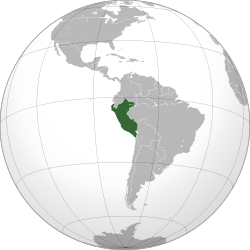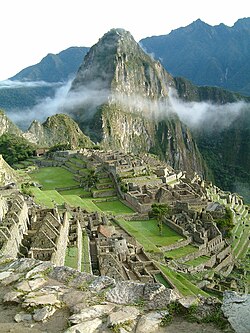Peru
Coordinates: 10°S 76°W / 10°S 76°W
Peru (![]() i/pəˈruː/; Spaingie: Perú [peˈɾu]; Quechua: Piruw [pɪɾʊw];[9] Aymara: Piruw [pɪɾʊw]), officially the Republic of Peru (Spaingie:
i/pəˈruː/; Spaingie: Perú [peˈɾu]; Quechua: Piruw [pɪɾʊw];[9] Aymara: Piruw [pɪɾʊw]), officially the Republic of Peru (Spaingie: ![]() República del Perú (help·info)), is a country in western South America. It is bordered in the north by Ecuador and Colombia, in the east by Brazil, in the southeast by Bolivia, in the south by Chile, and in the south and west by the Pacific Ocean. Peru is a megadiverse country with habitats ranging from the arid plains of the Pacific coastal region in the west to the peaks of the Andes mountains extending from the north to the southeast of the country to the tropical Amazon Basin rainforest in the east with the Amazon river.[10] Peru has a population of 34 million, and its capital and largest city is Lima. At 1.28 million km2 (0.5 million mi2), Peru is the 19th largest country in the world, and the third largest in South America.
República del Perú (help·info)), is a country in western South America. It is bordered in the north by Ecuador and Colombia, in the east by Brazil, in the southeast by Bolivia, in the south by Chile, and in the south and west by the Pacific Ocean. Peru is a megadiverse country with habitats ranging from the arid plains of the Pacific coastal region in the west to the peaks of the Andes mountains extending from the north to the southeast of the country to the tropical Amazon Basin rainforest in the east with the Amazon river.[10] Peru has a population of 34 million, and its capital and largest city is Lima. At 1.28 million km2 (0.5 million mi2), Peru is the 19th largest country in the world, and the third largest in South America.
Republic o Peru | |
|---|---|
Motto: "Firme y feliz por la unión" (Spaingie) "Firm and Happy for the Union" | |
 | |
| Caipital and largest city | Lima 12°2.6′S 77°1.7′W / 12.0433°S 77.0283°W |
| Offeecial leidsa | |
| Ethnic groups (2013) |
|
| Releegion |
|
| Demonym(s) | Peruvian |
| Govrenment | Unitar semi-presidential republic[3][4] |
• Preses | Pedro Castillo |
| Dina Boluarte | |
| Aníbal Torres | |
| Maricarmen Alva | |
| Legislatur | Congress o the Republic |
| Unthirldom frae the Kinrick o Spain | |
• Declared | 28 Julie 1821 |
| 9 December 1824 | |
• Recognised | 14 August 1879 |
| Aurie | |
• Total | 1,285,216 km2 (496,225 sq mi) (19t) |
• Water (%) | 0.41 |
| Population | |
• 2021 estimate | 34,294,231[5] (44th) |
• 2017 census | 31,237,385 |
• Density | 23/km2 (59.6/sq mi) (198th) |
| GDP (PPP) | 2020 estimate |
• Total | |
• Per capita | |
| GDP (nominal) | 2020 estimate |
• Tot | |
• Per capita | |
| Gini (2019) | medium |
| HDI (2019) | heich · 79th |
| Currency | Sol (PEN) |
| Time zone | UTC−5 (PET) |
| Date format | dd/mm/yyyy (CE) |
| Drivin side | right |
| Cawin code | +51 |
| ISO 3166 code | PE |
| Internet TLD | .pe |
Peruvian territory was home to several ancient cultures. Ranging from the Norte Chico civilization starting in 3500 BCE, the oldest civilization in the Americas and one of the five cradles of civilization, to the Inca Empire, the largest state in the pre-Columbian Americas, the territory now including Peru has one of the longest histories of civilization of any country, tracing its heritage back to the 10th millennium BCE.
The Spanish Empire conquered the region in the 16th century and established a viceroyalty that encompassed most of its South American territories, with its capital in Lima. Higher education started in the Americas with the official establishment of the National University of San Marcos in Lima in 1551. Peru formally proclaimed independence in 1821, and following the foreign military campaigns of José de San Martín and Simón Bolívar, and the decisive battle of Ayacucho, Peru completed its independence in 1824. In the ensuing years, the country first suffered of political instability until a period of relative economic and political stability begun due to the explotaiton of guano. Later, the War of the Pacific (1879–1884) with Chile brought Peru to a state of crisis from wich the olygarchy seize power through the Civilista Party. In the 20th century, the country endured coups, social unrest, and internal conflicts, as well as periods of stability and economic upswing. In the 1990s, the country implemented a neoliberal economic model which is still in use to this day. As the 2000s commodities boom took place, Peru experienced a period of constant economic growth and a decrease in poverty.
The sovereign state of Peru is a representative democratic republic divided into 25 regions. Peru has a high level of human development[11] with an upper middle income level[12] ranking 82nd on the Human Development Index.[13] It is one of the region's most prosperous economies with an average growth rate of 5.9%[14] and it has one of the world's fastest industrial growth rates at an average of 9.6%.[15] Its main economic activities include mining, manufacturing, agriculture and fishing; along with other growing sectors such as telecommunications and |currency = Sol |currency_code = PEN |time_zone = PET |utc_offset = −5 |date_format = dd.mm.yyyy (CE) |drives_on = right |calling_code = +51 |cctld = .pe |footnote_a = Quechua, Aymara an ither indigenous leids are co-offeecial in the auries whaur thay predominate. }}


Peru is a kintra in wastren Sooth Americae. It is bordered on the north bi Ecuador an Colombie, on the east bi Brazil, on the sootheast bi Bolivie, on the sooth bi Chile, an on the wast bi the Paceefic Ocean. Peru is ane o the maist megadiverse kintras.
Lima is the caipital ceety o the kintra.
The Preses o Peru is Francisco Sagasti.
References
eedit- ↑ "Ethnic groups of Perú". CIA Factbook. Archived frae the original on 8 Mey 2020. Retrieved 30 October 2013.
- ↑ "Perú: Perfil Sociodemográfico" (PDF). Instituto Nacional de Estadística e Informática. p. 231. Archived (PDF) frae the original on 11 Februar 2020. Retrieved 27 September 2018.
- ↑ Shugart, Matthew Søberg (September 2005). "Semi-Presidential Systems: Dual Executive and Mixed Authority Patterns" (PDF). Graduate School of International Relations and Pacific Studies. United States: University of California, San Diego. Archived frae the original (PDF) on 19 August 2008. Retrieved 31 August 2017. Unknown parameter
|dead-url=ignored (help)CS1 maint: ref=harv (link) Archived 2008-08-19 at the Wayback Machine - ↑ Shugart, Matthew Søberg (December 2005). "Semi-Presidential Systems: Dual Executive And Mixed Authority Patterns" (PDF). French Politics. Palgrave Macmillan UK. 3 (3): 323–351. doi:10.1057/palgrave.fp.8200087. ISSN 1476-3427. OCLC 6895745903. Retrieved 31 August 2017.
Only in Latin America have all new democracies retained a pure presidential form, except for Peru (president-parliamentary) and Bolivia (assembly-independent).
CS1 maint: ref=harv (link) - ↑ "Perú: Estimaciones y Proyecciones de Población Total, por Años Calendario y Edades Simples, 1950–2050" [Peru: Estimates and Projections of Total Population, by Calendar Years and Simple Ages, 1950–2050] (PDF) (in Spainish). National Institute of Statistics and Informatics. September 2009. Archived (PDF) frae the original on 18 September 2018. Retrieved 18 September 2018.
- ↑ a b c d "Peru". International Monetary Fund. Archived frae the original on 17 Januar 2021. Retrieved 18 Januar 2020.
- ↑ "Gini Index". World Bank. Archived frae the original on 7 Mey 2020. Retrieved 14 Julie 2021.
- ↑ Human Development Report 2020 The Next Frontier: Human Development and the Anthropocene (PDF). United Nations Development Programme. 15 December 2020. pp. 343–346. ISBN 978-92-1-126442-5. Archived (PDF) frae the original on 15 December 2020. Retrieved 16 December 2020.
- ↑ Quechua name used by government of Peru is Perú (see Quechua-language version of Peru Parliament website Archived 30 Julie 2010 at the Wayback Machine and Quechua-language version of Peru Constitution but common Quechua name is Piruw
- ↑ "Perú: País megadiverso" [Peru: Megadiverse country] (PDF) (in Spainish). Servicio Nacional de Áreas Naturales Protegidas. Archived frae the original (PDF) on 22 Juin 2014.
- ↑ Cite error: Invalid
<ref>tag; no text was provided for refs namedUNDP - ↑ Cite error: Invalid
<ref>tag; no text was provided for refs namedWBdata - ↑ "World Economic and Financial Surveys, World Economic Outlook October 2015" (PDF). www.imf.org. Archived (PDF) frae the original on 13 Januar 2017. Retrieved 15 Februar 2018.
- ↑ "Peru Overview". World Bank. Archived frae the original on 5 Mey 2017. Retrieved 17 Apryle 2017.
- ↑ "Peru". The World Factbook. Central Intelligence Agency. Archived frae the original on 7 Julie 2018. Retrieved 8 Januar 2018.
| Wikimedia Commons haes media relatit tae Peru. |
| This Sooth Americae-relatit airticle is a stub. Ye can help Wikipaedia bi expandin it. |
Cite error: <ref> tags exist for a group named "lower-alpha", but no corresponding <references group="lower-alpha"/> tag was found


